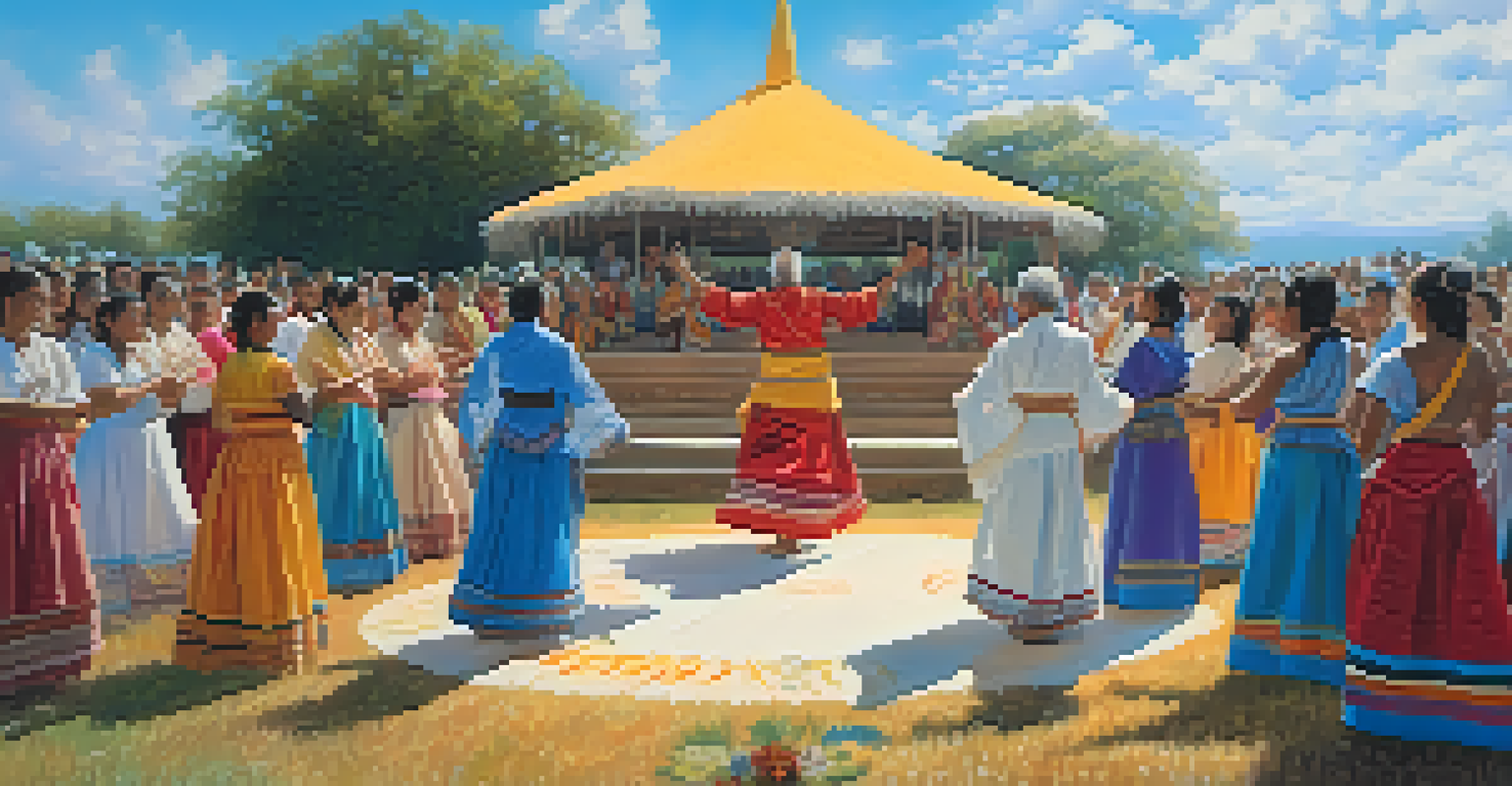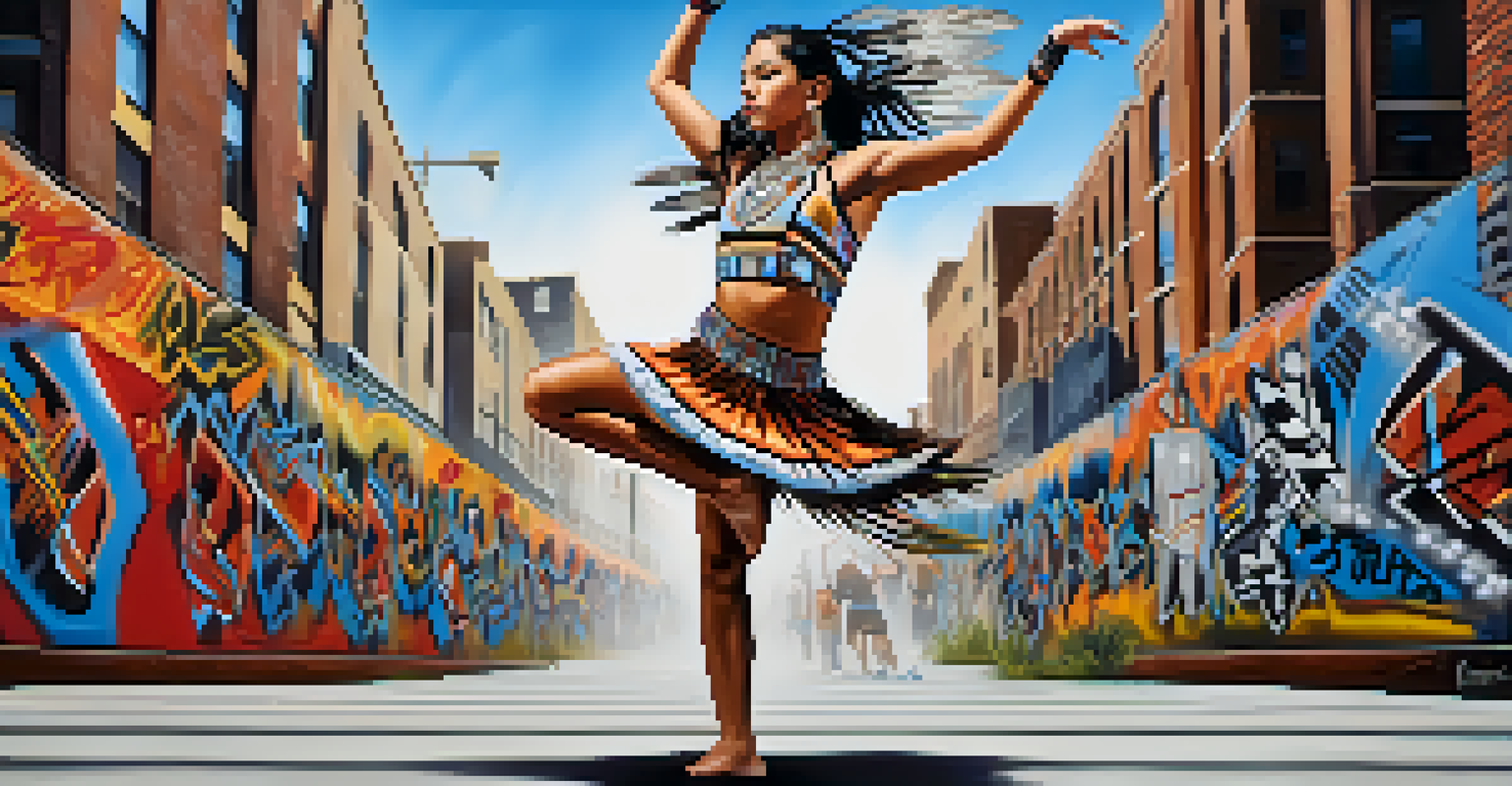The Role of Dance in Native American Cultural Expression Today

Dance as a Living Tradition in Native American Cultures
Dance is not just an art form for many Native American communities; it is a vital expression of their identity and heritage. It serves as a living tradition, continuously evolving while maintaining its deep-rooted connections to history and spirituality. Each dance carries stories and teachings passed down through generations, making it a powerful link between the past and present.
Dance is the hidden language of the soul.
For instance, powwow dances—often featuring vibrant regalia and rhythmic drumming—celebrate community and resilience. These gatherings attract people from various tribes, fostering unity and cultural exchange. They also offer a platform for younger generations to learn and participate, ensuring that these traditions endure.
Furthermore, dances are often tied to significant life events such as births, marriages, and memorials, making them integral to the social fabric of Native American life. This blend of celebration and reverence illustrates how dance is a multifaceted expression of culture, serving both communal and personal purposes.
Spiritual Significance of Dance in Indigenous Practices
In many Native American cultures, dance is considered a spiritual practice that connects individuals with the divine. It is often performed as a form of prayer or meditation, channeling energy into the spirit world. This connection to the spiritual realm highlights the importance of dance beyond mere performance; it is a sacred act.

For example, the Sun Dance, a significant ritual for several Plains tribes, involves physical endurance and spiritual offerings. Participants dance and fast for days, seeking visions and healing not only for themselves but for their communities. This illustrates how dance is intertwined with spiritual beliefs and practices.
Dance Preserves Cultural Heritage
Dance acts as a vital tool for preserving Native American cultures, ensuring traditions are passed down to younger generations.
Moreover, the use of dance in healing ceremonies reflects its role in promoting mental and emotional well-being. By invoking spirits through movement and rhythm, individuals find solace and strength, reinforcing the idea that dance is a holistic practice encompassing body, mind, and spirit.
Dance as a Tool for Cultural Preservation
In today's fast-paced world, dance serves as a crucial tool for preserving Native American cultures. Through workshops, performances, and educational programs, dancers are able to share their stories and traditions with younger generations. This not only fosters pride in their heritage but also combats cultural assimilation.
The dance is a poem of which each movement is a word.
Organizations dedicated to cultural preservation often host events that highlight traditional dances, encouraging community involvement. These gatherings allow families to engage with their heritage, teaching children the significance of their cultural practices through firsthand experience.
Additionally, the use of social media and digital platforms has expanded the reach of Native American dance beyond local communities. By sharing videos and tutorials online, dancers can connect with a global audience, raising awareness and appreciation for their cultural expressions.
The Role of Dance in Contemporary Native American Identity
In contemporary society, dance plays a vital role in shaping Native American identity. Many young people are using dance as a way to assert their cultural identity in an increasingly homogenized world. This reclamation of traditions is empowering, allowing individuals to express their heritage proudly.
For instance, hip-hop and modern dance styles are being blended with traditional movements, creating new forms of expression that resonate with younger generations. This fusion highlights the adaptability of Native American culture and demonstrates how tradition can coexist with contemporary influences.
Spiritual Connection Through Dance
In many Native American cultures, dance serves as a spiritual practice that connects individuals with the divine and promotes healing.
Moreover, dance competitions and showcases provide platforms for Native American dancers to gain recognition and celebrate their heritage. These events not only honor traditional practices but also inspire creativity and innovation within the dance community.
Community and Connection Through Dance
Dance fosters a sense of community among Native Americans, acting as a unifying force that brings individuals together. Whether at powwows or local gatherings, participants share a bond that transcends tribal affiliations. This camaraderie strengthens social ties and reinforces cultural identity.
Moreover, dance events often serve as opportunities for storytelling, where elders pass down knowledge through movement and song. This intergenerational exchange is essential for maintaining cultural continuity, as it allows younger generations to learn about their roots in a meaningful way.
Through collective participation in dance, individuals not only celebrate their own identities but also contribute to the larger narrative of Native American culture. This sense of belonging is vital in reinforcing community resilience and pride.
Dance and Advocacy for Native American Rights
Dance has also become a powerful form of advocacy for Native American rights. Many dancers and choreographers use their art to raise awareness about social and political issues affecting their communities. This form of activism highlights the ongoing struggles faced by Native American peoples today.
For example, performances that address themes of land rights, environmental justice, or cultural appropriation can spark important conversations. By integrating these themes into their dance, artists create a platform for dialogue and reflection, encouraging audiences to consider their role in supporting Indigenous rights.
Dance Fosters Community and Unity
Dance creates a sense of community among Native Americans, reinforcing cultural identity and facilitating intergenerational knowledge sharing.
Furthermore, collaborating with other artists and activists can amplify their message, creating a broader movement for change. Dance thus becomes a medium for not only artistic expression but also social justice, highlighting the integral relationship between culture and advocacy.
The Future of Dance in Native American Communities
As we look to the future, the role of dance in Native American communities remains vital and dynamic. Innovations in dance styles and the incorporation of technology will likely continue to shape how traditions are expressed and shared. This evolution can help ensure that cultural practices remain relevant to younger generations.
Moreover, the growing interest in Native American culture among non-Indigenous audiences presents both challenges and opportunities. It encourages greater appreciation for these traditions but also raises questions about cultural appropriation and authenticity. Navigating these issues will be crucial for the sustainability of dance as a cultural expression.

Ultimately, the future of dance in Native American communities will depend on the continued commitment to cultural preservation, community engagement, and advocacy. By embracing both tradition and innovation, Native American dance can thrive and inspire future generations.